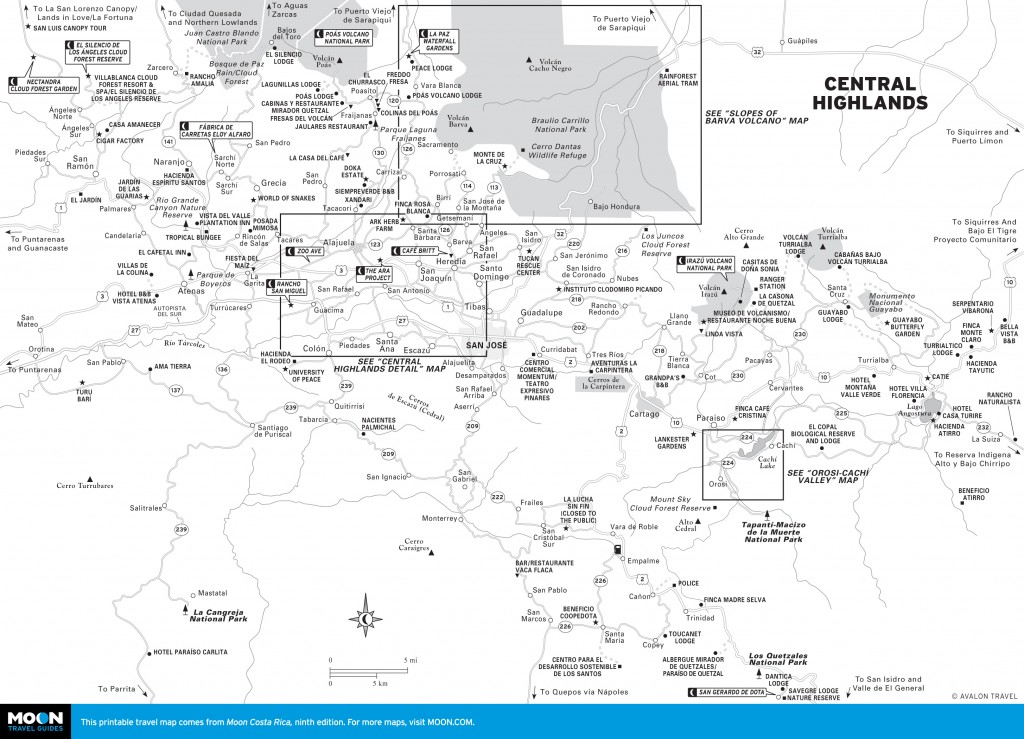
The water in the Diego de la Heya crater can range from pea-green to rust-red. Photo © Ben Haeringer, licensed Creative Commons Attribution No-Derivatives.
The slopes north of Cartago rise gradually to the summit of Volcán Irazú; it’s a 21-kilometer (13-mile) journey to the entrance to Parque Nacional Volcán Irazú (tel. 506/2200-5025, [email protected], 8am-3:30pm daily, $10). The slopes are dotted with tidy farming villages of pastel houses. Dairy farming is important, and the fertile fields around the village of Cot are veritable salad bowls—carrots, onions, potatoes, and greens are grown intensively. Don’t be put off if the volcano is shrouded in fog. Often the clouds lie below the summit of the mountain—there’s no way of telling until you drive up there—and you’ll emerge into brilliant sunshine as you ascend.Volcán Irazú (3,432 meters/11,260 feet) derives its name from two words from indigenous languages: ara (point) and tzu (thunder). The volcano has been ephemerally active, most famously on March 13, 1963, the day that U.S. president John F. Kennedy landed in Costa Rica on an official visit; Irazú broke a 20-year silence and began disgorging great columns of smoke and ash.The windswept 100-meter-deep (330-foot-deep) Diego de la Haya crater contains a sometimes-pea-green, sometimes-rust-red mineral-tinted lake. A larger crater—one of five craters to be seen—is 300 meters (980 feet) deep. Two separate trails lead from the parking lot to the craters. Follow those signed with blue-and-white symbols (don’t follow other trails made by irresponsible folks whose feet destroy the fragile ecosystems). The crater rims are dangerously unstable; keep your distance.
A sense of bleak desolation pervades the summit, like the surface of the moon. It is often foggy. Even on a sunny day expect a cold, dry, biting wind. Dress warmly. Little vegetation lives at the summit, though stunted dwarf oaks, ferns, lichens, and other species are making a comeback. The best time to visit is March or April.
Don’t be put off if the volcano is shrouded in fog. Often the clouds lie below the summit of the mountain—there’s no way of telling until you drive up there—and you’ll emerge into brilliant sunshine as you ascend. On a clear day you can see both the Pacific and Atlantic Oceans. The earlier in the morning you arrive, the better.
The ranger booth is two kilometers (1.2 miles) below the summit, where there’s a café and toilets.
The privately run Museo Vulcanológico (Museum of Volcanology, tel. 506/2305-8013, 8am-3:30pm daily, $4), two kilometers (1.2 miles) below the ranger station, offers an excellent introduction to the processes of volcanology and specifically to the geology and history of the Irazú volcano and its effects on the local community. Trails lead to a lookout and waterfalls.
Restaurante y Cabañas El Volcán (tel. 506/8352-5129, $30 s/d), one kilometer (0.6 miles) below the ranger station, has 12 rustic cabins with heaters and private hot-water baths. It has a pleasant albeit rustic restaurant (8:30am-4pm Thurs.-Tues., $1-8) with counter seating around an open oven. It serves hearty local fare, such as ceviche and sopa de modongo.
Restaurant Nochebuena (tel. 506/2503- 8013, $25 pp), beside the Museo Vulcanológico, has a rustic three-room cabin with a fireplace and a kitchen. The restaurant (9am-4pm daily) is modestly elegant; the menu ranges from posole (thick corn soup with pork, onions, and oregano, $4) to grilled sirloin steak ($8).
Farther uphill, Bar/Restaurante Linda Vista (tel. 506/8386-9097, $20 s, $25 d) has a simple A-frame cabin for five people, with hot water and fabulous views. It claims to be the highest restaurant in Central America, at 2,693 meters (8,835 feet). Take your business card to pin to the walls. It serves típico dishes (average $6) and sandwiches 7am-6pm daily.
Enjoying a lovely location on the lower slopes, Grandpa’s B&B (tel. 506/2536-7418, standard $40 s, $65 d, junior suite $45 s, $70 d) is an old house on a working farm 400 meters (0.25 miles) above the Christ statue near Cot. It has five simply appointed bedrooms with terra-cotta floors and nice hardwood beds. The huge main bedroom has its own fireplace.
Buses (tel. 506/2530-1064) depart San José ($3) from Avenida 2, Calles 1 and 3, at 8am daily, returning at 12:30pm daily. You can also hop aboard this bus in Cartago on Avenida 2, by Las Ruinas.
A taxi will cost upward of $25 from Cartago.
If you drive from Cartago, take the road leading northeast from the Basílica. At a Y junction just below Cot, seven kilometers (4.5 miles) northeast of Cartago, is a statue of Jesus, his arms outstretched as if to embrace the whole valley. The road to the right leads to Pacayas, Santa Cruz, and Guayabo National Monument. That to the left leads to Parque Nacional Volcán Irazú (turn right before Tierra Blanca; Irazú is signed).

Central Highlands
Excerpted from the Ninth Edition of Moon Costa Rica.